Finite Control Set Model Predictive Control for an LCL-Filtered Grid-Tied Inverter with Full Status Estimations under Unbalanced Grid Voltage
Abstract
1. Introduction
2. Conventional FCS-MPC Method for LCL-Filtered Grid-Tied Inverter
2.1. Discrete-Time Model of LCL Filter
2.2. Conventional FCS-MPC Scheme
- Measure i1, i2, uc, and vg by using the current and voltage sensors;
- Calculate and according to the given reference of grid-injected current ;
- Deduce the references of three state variables at next step by utilizing the Lagrangian Extrapolation method;
- Obtain the predictions of three state variables in the next sampling instant x (k + 1) for all possible inverter output voltage vectors based on the discrete-time model of the LCL filter expressed in Equation (4);
- Construct the cost function and define the weighting factor;
- Select the optimal inverter output voltage vector by minimizing the cost function;
- Acquire the driving signal according to Table 1.
3. Theoretical Analysis of the Proposed FCS-MPC Scheme with Full Status Estimations under Unbalanced Grid Voltage Condition
3.1. Grid Voltage Observer
3.2. Luenberger Observer
3.3. Sequence Extractor
3.4. Reference Generator
4. Detailed Implementation of the Proposed FCS-MPC Strategy
- Measure the grid-injected currents of phase a and b, and deduce the c-phase grid-injected current by
- Estimate the grid voltage by utilizing the GVO based on Equations (9)–(12);
- Estimate the inverter-side inductor current , the grid-injected current , and the capacitor voltage by using the Luenberger observer, which is based on the observed grid voltages and the measured grid-injected currents;
- Obtain the reference of grid-injected current in αβ stationary coordinate system based on Equation (29), (31), or (33);
- Deduce the references of the inverter-side current and the capacitor voltage in αβ stationary coordinate system based on and .
- Calculate the references of the three estimated state variables x* at the (k + 2)th instant by utilizing the Lagrangian extrapolation, which can be expressed as (x = [i1 i2 uc]T):
- Predict the three estimated state variables x at the (k + 1)th instant according to Equation (4), and calculate the estimated grid voltage at the (k + 1)th instant by
- Predict the three estimated state variables x at the (k + 2)th instant, which is based on the discrete-time model of the LCL filter described in Equation (4);
- Construct the following cost function and then each voltage vector described in Table 1 is taken into the cost function. Consequently, seven different value of cost functions J can be obtained.where ε are the errors of controlled variables between reference value and estimated value. The weighting factor λuc is set to achieve active damping [27], and λi2 is tuned to obtain a high quality grid-injected current [12], and the weighting factors are designed according to [28].
- The inverter voltage vector with minimum cost function viopt is selected. Correspondingly, the driving signals can be deduced according to Table 1.
5. Simulation Results
6. Experimental Results
7. Conclusions
- By utilizing the proposed control algorithm, the errors between observations and measurements are small enough under both balanced and unbalanced grid voltages, and the observations have a good dynamic response. Therefore, these observations can replace the measurements used in the control.
- Under the unbalanced grid voltage condition, the proposed FCS-MPC strategy obtains the satisfactory performance in both the steady and dynamic states for three different control targets. Note that only the grid-injected currents are measured.
Author Contributions
Funding
Conflicts of Interest
References
- Blaabjerg, F.; Yang, Y.; Yang, D.; Wang, X. Distributed Power-Generation Systems and Protection. Proc. IEEE 2017, 105, 1311–1331. [Google Scholar] [CrossRef]
- Kouro, S.; Leon, J.I.; Vinnikov, D.; Franquelo, L.G. Grid-Connected Photovoltaic Systems: An Overview of Recent Research and Emerging PV Converter Technology. IEEE Ind. Electron. Mag. 2015, 9, 47–61. [Google Scholar] [CrossRef]
- Wu, W.; Liu, Y.; He, Y.; Chung, H.S.; Liserre, M.; Blaabjerg, F. Damping Methods for Resonances Caused by LCL-Filter-Based Current-Controlled Grid-Tied Power Inverters: An Overview. IEEE Trans. Ind. Electron. 2017, 64, 7402–7413. [Google Scholar] [CrossRef]
- Liu, Y.; Wu, W.; He, Y.; Lin, Z.; Blaabjerg, F.; Chung, H.S. An Efficient and Robust Hybrid Damper for LCL-or LLCL-Based Grid-Tied Inverter with Strong Grid-Side Harmonic Voltage Effect Rejection. IEEE Trans. Ind. Electron. 2016, 63, 926–936. [Google Scholar] [CrossRef]
- Ahmed, A.; Koh, B.K.; Lee, Y.I. A Comparison of Finite Control Set and Continuous Control Set Model Predictive Control Schemes for Speed Control of Induction Motors. IEEE Trans. Ind. Inform. 2018, 14, 1334–1346. [Google Scholar] [CrossRef]
- Vieira, R.P.; Martins, L.T.; Massing, J.R.; Stefanello, M. Sliding Mode Controller in a Multiloop Framework for a Grid-Connected VSI with LCL Filter. IEEE Trans. Ind. Electron. 2018, 65, 4714–4723. [Google Scholar] [CrossRef]
- Mu, X.; Wang, J.; Wu, W.; Blaabjerg, F. A Modified Multifrequency Passivity-Based Control for Shunt Active Power Filter with Model-Parameter-Adaptive Capability. IEEE Trans. Ind. Electron. 2018, 65, 760–769. [Google Scholar] [CrossRef]
- Kouro, S.; Cortes, P.; Vargas, R.; Ammann, U.; Rodriguez, J. Model Predictive Control—A Simple and Powerful Method to Control Power Converters. IEEE Trans. Ind. Electron. 2009, 56, 1826–1838. [Google Scholar] [CrossRef]
- Rodriguez, J.; Kazmierkowski, M.P.; Espinoza, J.R.; Zanchetta, P.; Abu-Rub, H.; Young, H.A.; Rojas, C.A. State of the Art of Finite Control Set Model Predictive Control in Power Electronics. IEEE Trans. Ind. Inform. 2013, 9, 1003–1016. [Google Scholar] [CrossRef]
- Yaramasu, V.; Rivera, M.; Wu, B.; Rodriguez, J. Model Predictive Current Control of Two-Level Four-Leg Inverters—Part I: Concept, Algorithm, and Simulation Analysis. IEEE Trans. Power Electron. 2013, 28, 3459–3468. [Google Scholar] [CrossRef]
- Xia, C.; Liu, T.; Shi, T.; Song, Z. A Simplified Finite-Control-Set Model-Predictive Control for Power Converters. IEEE Trans. Ind. Inform. 2014, 10, 991–1002. [Google Scholar]
- Falkowski, P.; Sikorski, A. Finite Control Set Model Predictive Control for Grid-Connected AC–DC Converters with LCL Filter. IEEE Trans. Ind. Electron. 2018, 65, 2844–2852. [Google Scholar] [CrossRef]
- Liang, J.; Wang, H.; Yan, Z. Grid Voltage Sensorless Model based Predictive Power Control of PWM Rectifiers Based on Sliding Mode Virtual Flux Observer. IEEE Access 2019, 7, 24007–24016. [Google Scholar] [CrossRef]
- Zhang, H.; Zhu, X.; Shi, J.; Tan, L.; Zhang, C.; Hu, K. Study on PWM Rectifier Without Grid Voltage Sensor Based on Virtual Flux Delay Compensation Algorithm. IEEE Trans. Power Electron. 2019, 34, 849–862. [Google Scholar] [CrossRef]
- Yoon, S.; Lai, N.; Kim, K. A Systematic Controller Design for a Grid-Connected Inverter with LCL Filter Using a Discrete-Time Integral State Feedback Control and State Observer. Energies 2018, 11, 437. [Google Scholar] [CrossRef]
- Kukkola, J.; Hinkkanen, M. State Observer for Grid-Voltage Sensorless Control of a Converter Equipped with an LCL Filter: Direct Discrete-Time Design. IEEE Trans. Ind. Appl. 2016, 52, 3133–3145. [Google Scholar] [CrossRef]
- Yang, H.; Zhang, Y.; Liang, J.; Liu, J.; Zhang, N.; Walker, P.D. Robust Deadbeat Predictive Power Control with a Discrete-Time Disturbance Observer for PWM Rectifiers Under Unbalanced Grid Conditions. IEEE Trans. Power Electron. 2019, 34, 287–300. [Google Scholar] [CrossRef]
- Camacho, A.; Castilla, M.; Miret, J.; Borrell, A.; de Vicuña, L.G. Active and Reactive Power Strategies with Peak Current Limitation for Distributed Generation Inverters During Unbalanced Grid Faults. IEEE Trans. Ind. Electron. 2015, 62, 1515–1525. [Google Scholar] [CrossRef]
- Zheng, X.; Wang, C.; Pang, S. Injecting positive-sequence current virtual synchronous generator control under unbalanced grid. IET Renew. Power Gener. 2019, 13, 165–170. [Google Scholar] [CrossRef]
- Suul, J.A.; Luna, A.; Rodriguez, P.; Undeland, T. Voltage-Sensor-Less Synchronization to Unbalanced Grids by Frequency-Adaptive Virtual Flux Estimation. IEEE Trans. Ind. Electron. 2012, 59, 2910–2923. [Google Scholar] [CrossRef]
- Yang, H.; Zhang, Y.; Liang, J.; Gao, J.; Walker, P.D.; Zhang, N. Sliding-Mode Observer Based Voltage-Sensorless Model Predictive Power Control of PWM Rectifier Under Unbalanced Grid Conditions. IEEE Trans. Ind. Electron. 2018, 65, 5550–5560. [Google Scholar] [CrossRef]
- Rodriguez, P.; Pou, J.; Bergas, J.; Candela, J.I.; Burgos, R.P.; Boroyevich, D. Decoupled Double Synchronous Reference Frame PLL for Power Converters Control. IEEE Trans. Power Electron. 2007, 22, 584–592. [Google Scholar] [CrossRef]
- Svensson, J.; Bongiorno, M.; Sannino, A. Practical Implementation of Delayed Signal Cancellation Method for Phase-Sequence Separation. IEEE Trans. Power Deliv. 2007, 22, 18–26. [Google Scholar] [CrossRef]
- Zhou, D.; Tu, P.; Tang, Y. Multivector Model Predictive Power Control of Three-Phase Rectifiers with Reduced Power Ripples Under Nonideal Grid Conditions. IEEE Trans. Ind. Electron. 2018, 65, 6850–6859. [Google Scholar] [CrossRef]
- Ma, K.; Chen, W.; Liserre, M.; Blaabjerg, F. Power Controllability of a Three-Phase Converter with an Unbalanced AC Source. IEEE Trans. Power Electron. 2015, 30, 1591–1604. [Google Scholar] [CrossRef]
- Chen, X.; Wu, W.; Gao, N.; He, Y.; Chung, H.S.; Blaabjerg, F. Finite Control Set Model Predictive Control for LCL-Filter-Based Grid-Tied Inverter with Computational Delay Compensation. In Proceedings of the 2018 IEEE International Power Electronics and Application Conference and Exposition (PEAC), Shenzhen, China, 4–7 November 2018; pp. 1–6. [Google Scholar]
- Panten, N.; Hoffmann, N.; Fuchs, F.W. Finite Control Set Model Predictive Current Control for Grid-Connected Voltage-Source Converters with LCL Filters: A Study Based on Different State Feedbacks. IEEE Trans. Power Electron. 2016, 31, 5189–5200. [Google Scholar] [CrossRef]
- Cortes, P.; Kouro, S.; Rocca, B.L.; Vargas, R.; Rodriguez, J.; Leon, J.I.; Vazquez, S.; Franquelo, L.G. Guidelines for weighting factors design in Model Predictive Control of power converters and drives. In Proceedings of the 2009 IEEE International Conference on Industrial Technology, Gippsland, Australia, 10–13 February 2009; pp. 1–7. [Google Scholar]
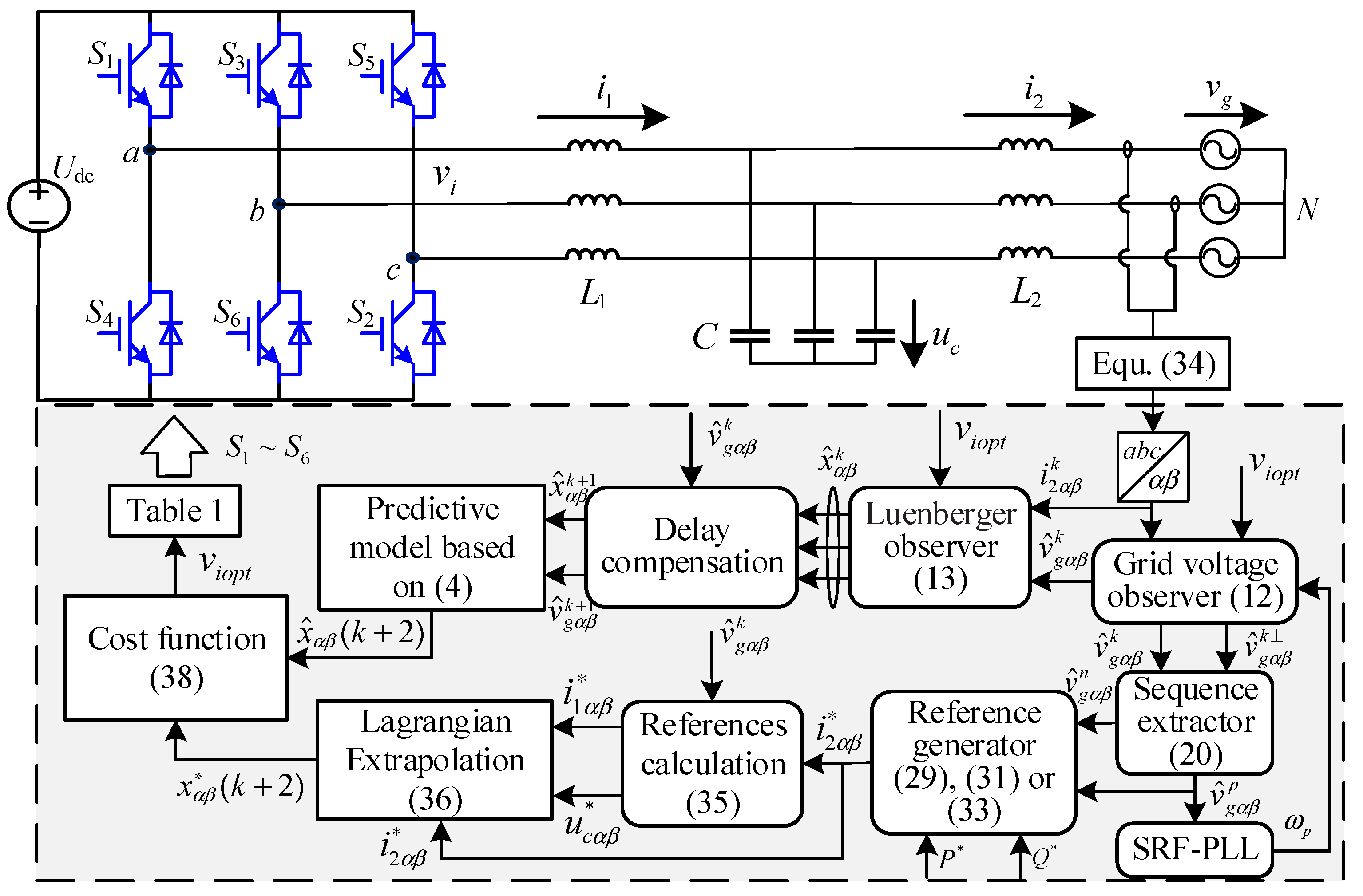

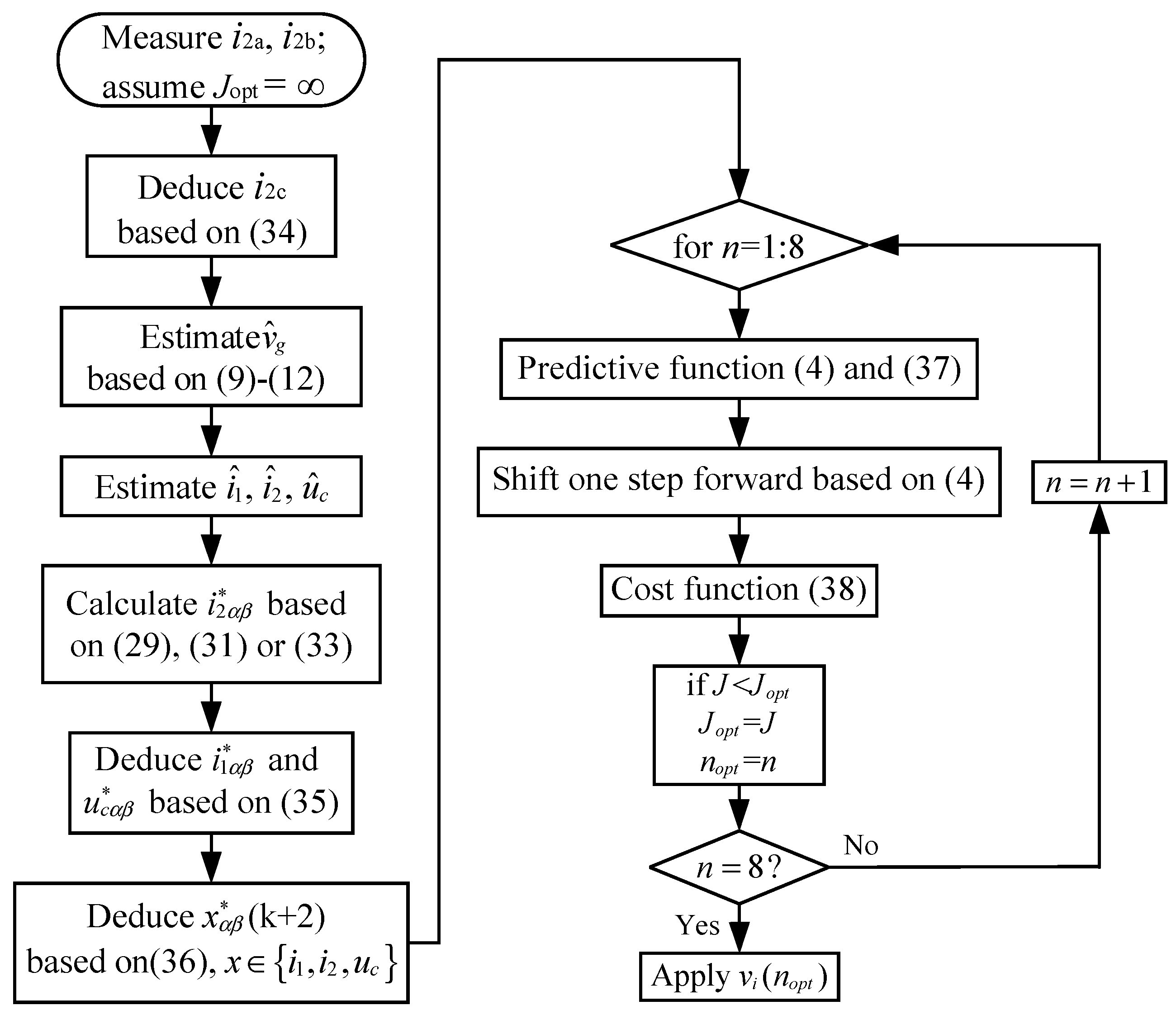
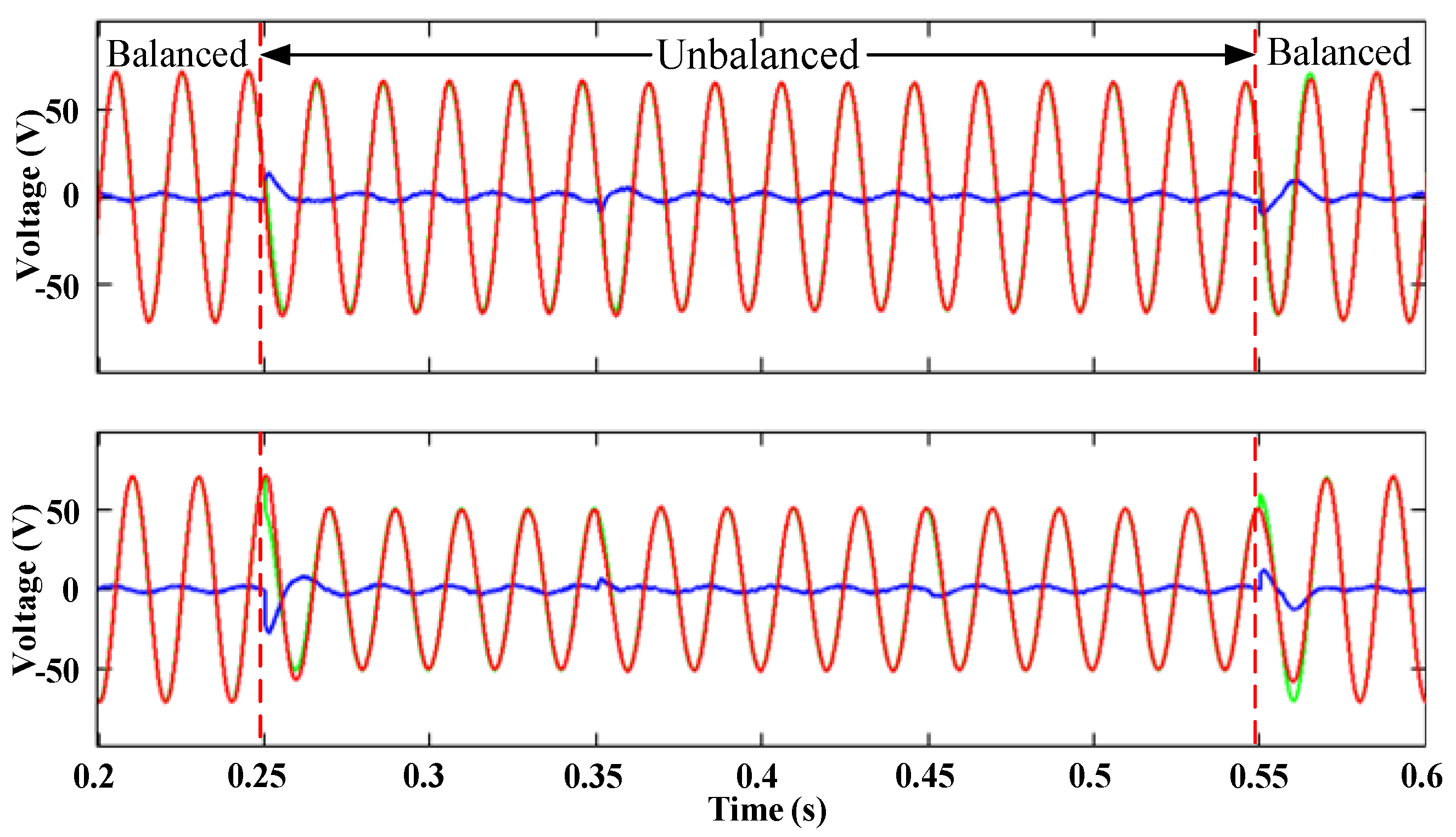


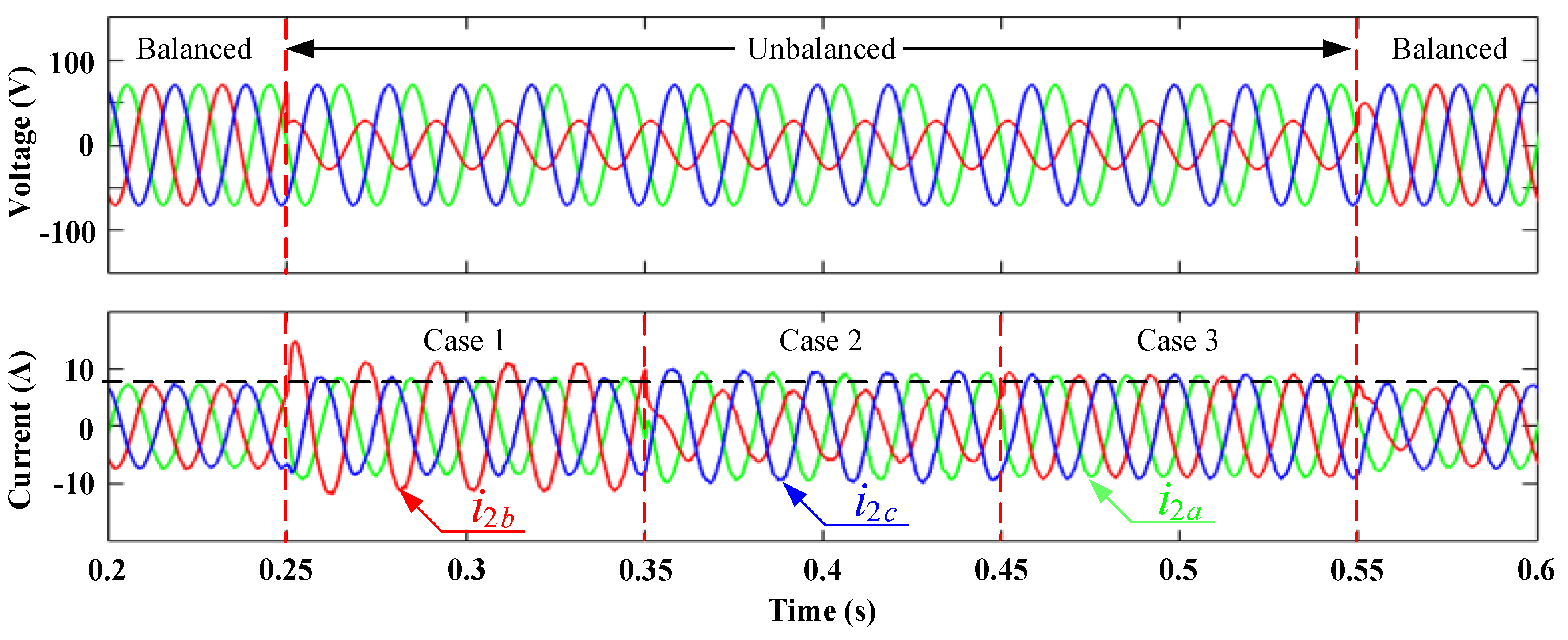





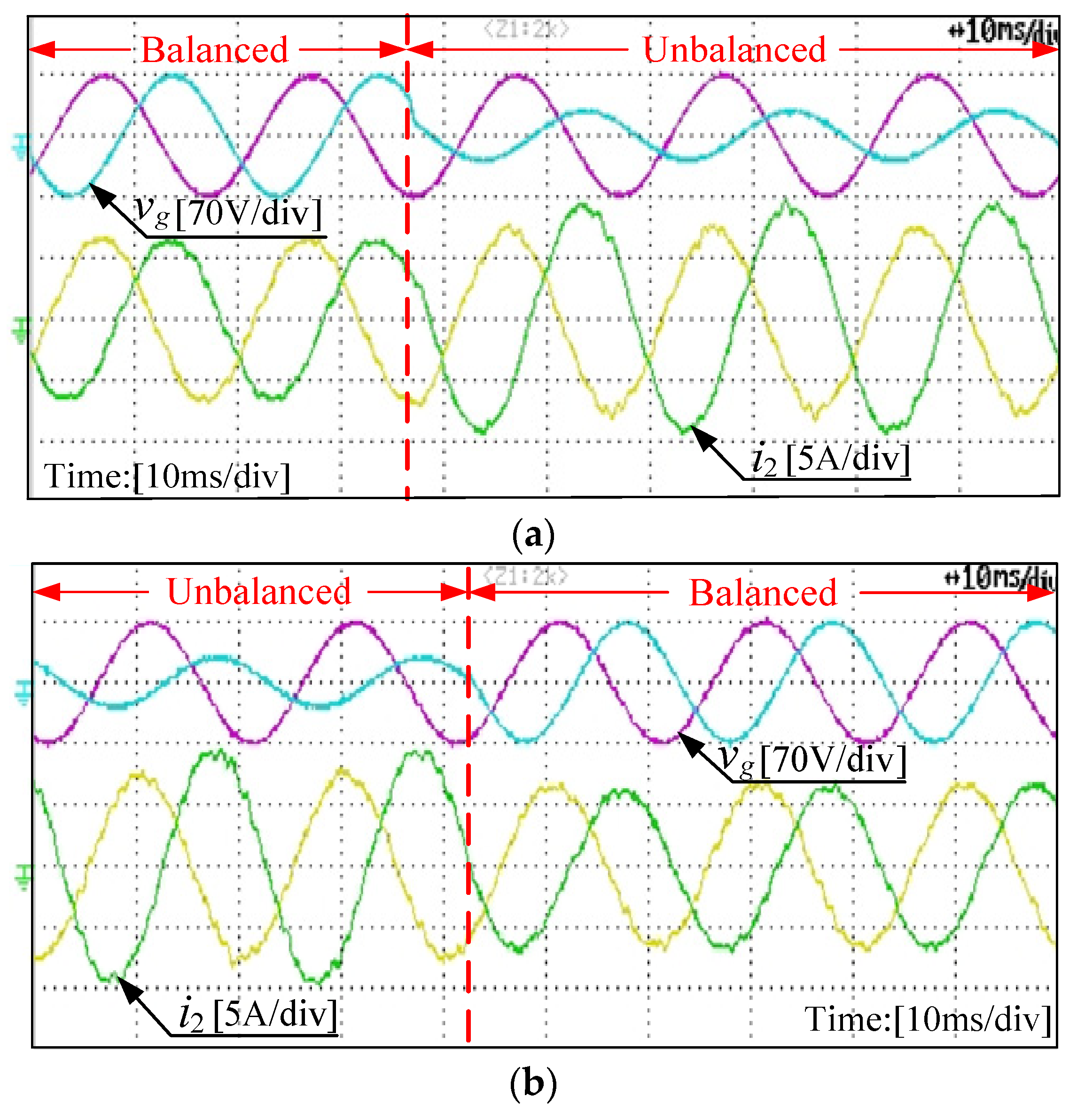

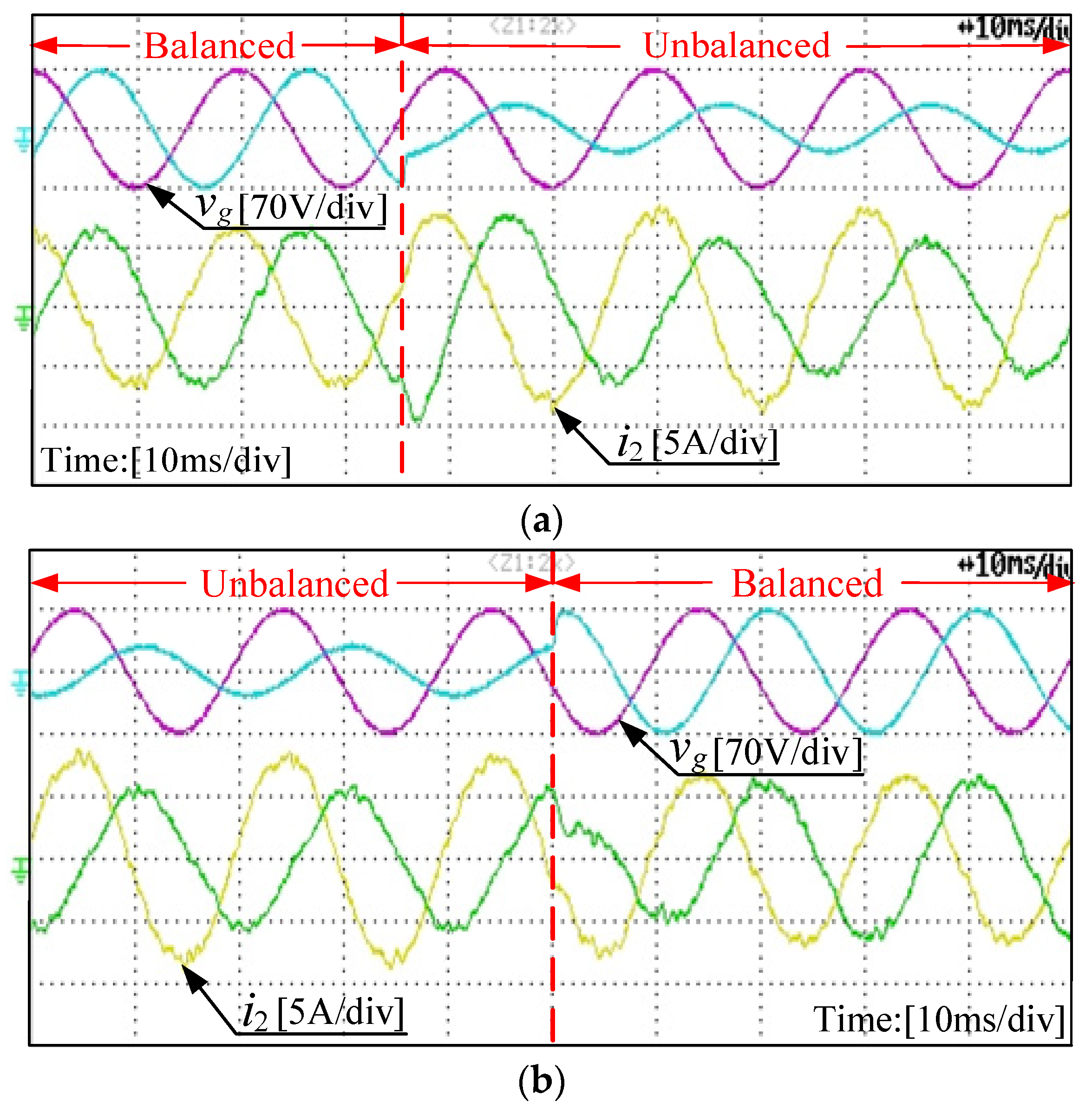
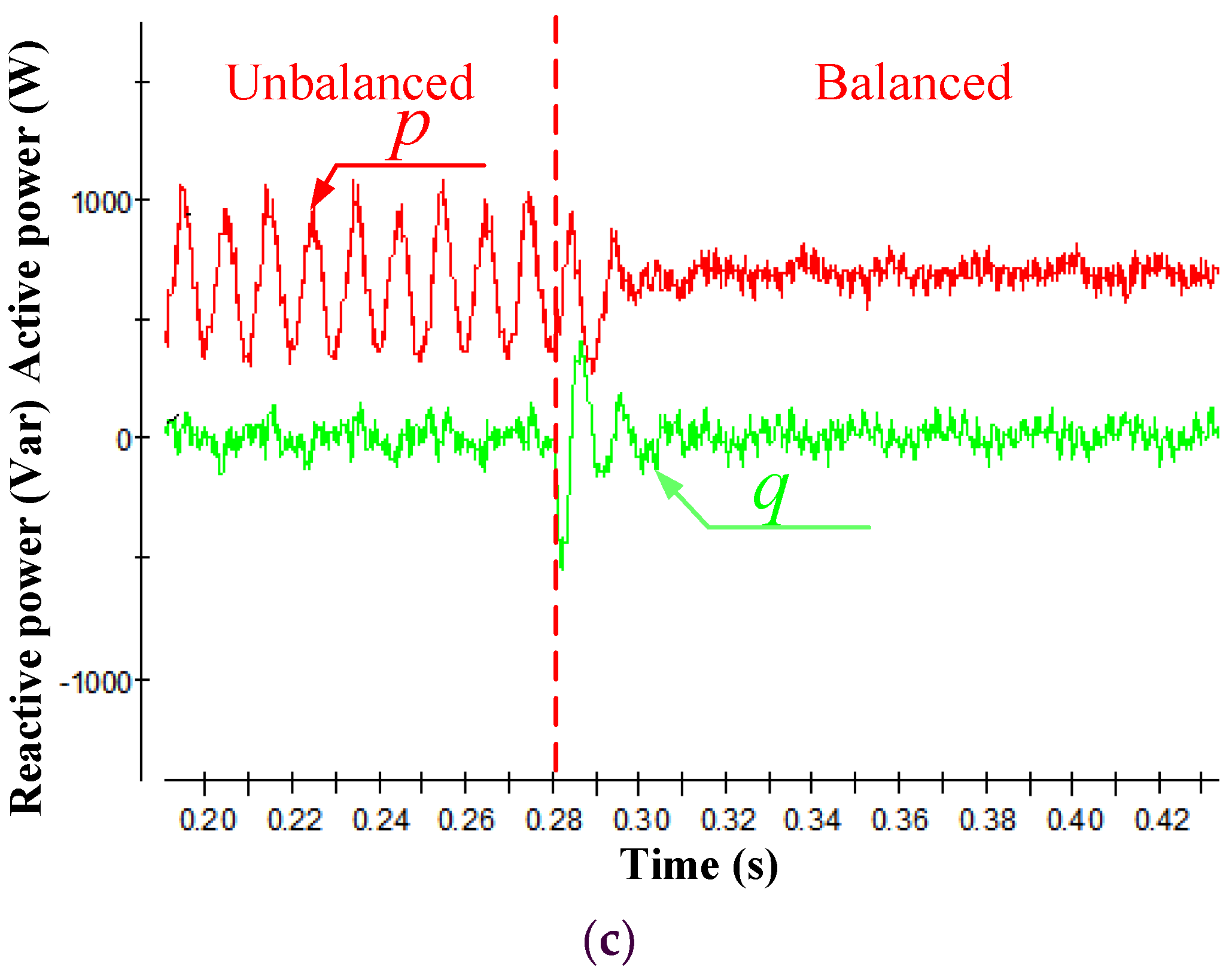

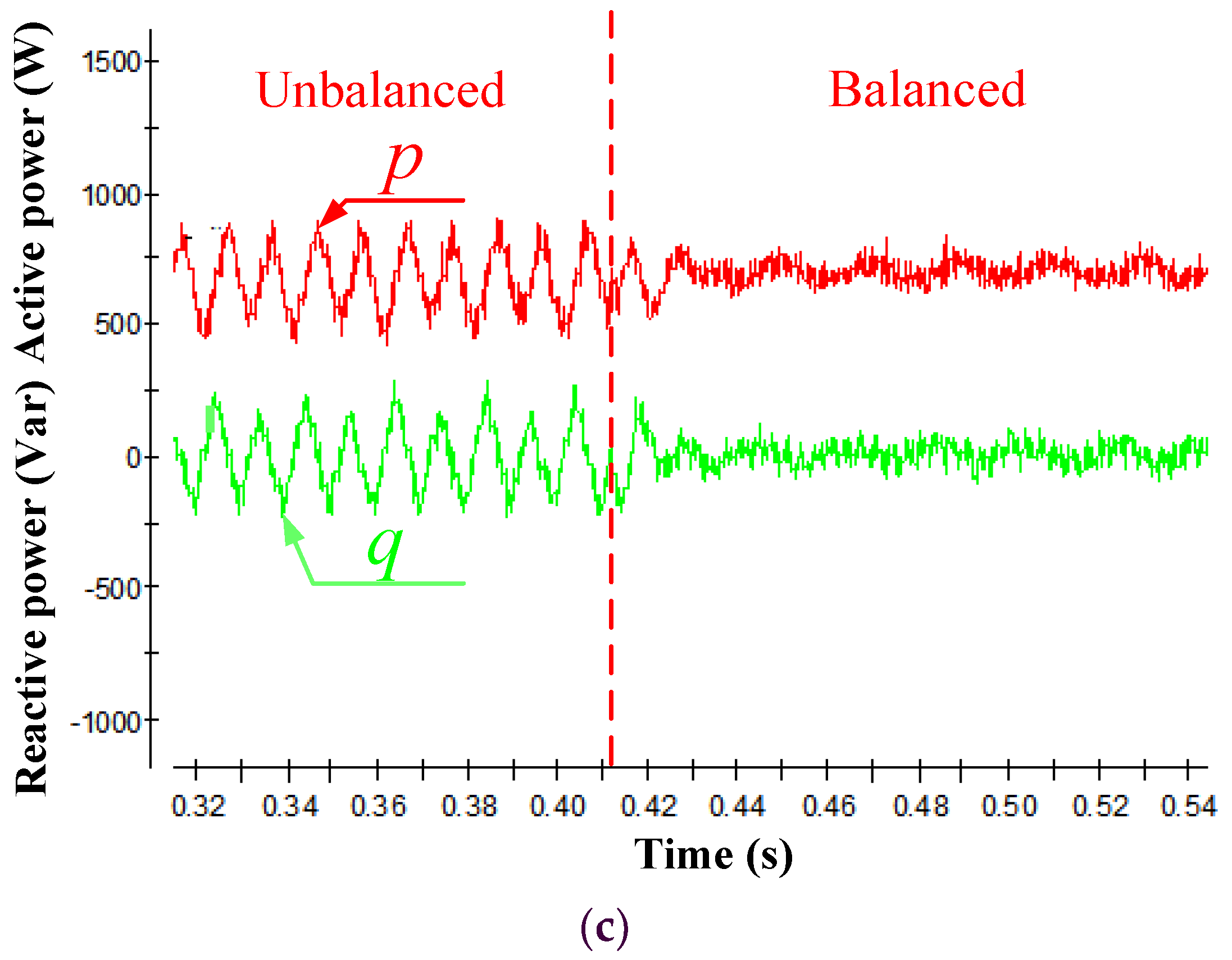
| Sa | Sb | Sc | Voltage Vector |
|---|---|---|---|
| 0 | 0 | 0 | 0 |
| 1 | 0 | 0 | |
| 1 | 1 | 0 | |
| 0 | 1 | 0 | |
| 0 | 1 | 1 | |
| 0 | 0 | 1 | |
| 1 | 0 | 1 | |
| 1 | 1 | 1 | 0 |
| Case 1 | Case 2 | Case 3 | |
|---|---|---|---|
| Double frequency ripples of active power | Not exist | Exist | Exist |
| Double frequency ripples of reactive power | Exist | Not exist | Exist |
| Grid-injected currents | Unbalanced Sinusoidal | Unbalanced Sinusoidal | Balanced Sinusoidal |
© 2019 by the authors. Licensee MDPI, Basel, Switzerland. This article is an open access article distributed under the terms and conditions of the Creative Commons Attribution (CC BY) license (http://creativecommons.org/licenses/by/4.0/).
Share and Cite
Chen, X.; Wu, W.; Gao, N.; Liu, J.; Chung, H.S.-H.; Blaabjerg, F. Finite Control Set Model Predictive Control for an LCL-Filtered Grid-Tied Inverter with Full Status Estimations under Unbalanced Grid Voltage. Energies 2019, 12, 2691. https://doi.org/10.3390/en12142691
Chen X, Wu W, Gao N, Liu J, Chung HS-H, Blaabjerg F. Finite Control Set Model Predictive Control for an LCL-Filtered Grid-Tied Inverter with Full Status Estimations under Unbalanced Grid Voltage. Energies. 2019; 12(14):2691. https://doi.org/10.3390/en12142691
Chicago/Turabian StyleChen, Xiaotao, Weimin Wu, Ning Gao, Jiahao Liu, Henry Shu-Hung Chung, and Frede Blaabjerg. 2019. "Finite Control Set Model Predictive Control for an LCL-Filtered Grid-Tied Inverter with Full Status Estimations under Unbalanced Grid Voltage" Energies 12, no. 14: 2691. https://doi.org/10.3390/en12142691
APA StyleChen, X., Wu, W., Gao, N., Liu, J., Chung, H. S.-H., & Blaabjerg, F. (2019). Finite Control Set Model Predictive Control for an LCL-Filtered Grid-Tied Inverter with Full Status Estimations under Unbalanced Grid Voltage. Energies, 12(14), 2691. https://doi.org/10.3390/en12142691






